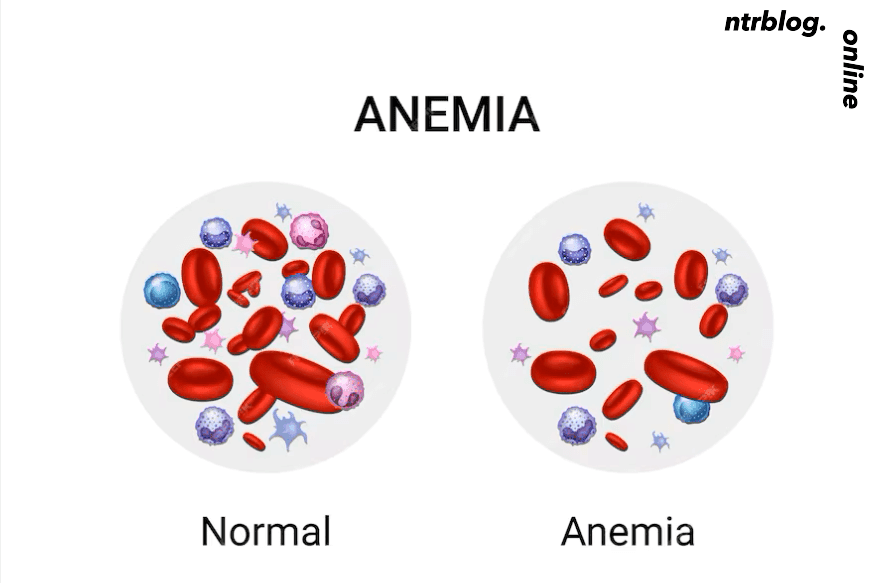- Anemia is a condition where your body lacks enough healthy red blood cells to efficiently transport oxygen, leaving you feeling drained, weak, and often short of breath. These symptoms can range from subtle to severe, and in some cases, anemia can pose a serious risk to your life. The causes behind anemia are varied, as are the types of the condition, meaning that the treatment plan will differ depending on the root cause.
Table of Contents
What is Anemia?
- At its core, anemia is a disorder related to the blood. It occurs either because the body isn’t producing enough red blood cells, or because the red blood cells present aren’t functioning properly. While some people may be born with certain forms of anemia, others develop it over time due to factors like poor nutrition, chronic illness, or exposure to toxins.
- The impact anemia can have on your daily life depends largely on the type. For some, it may present with symptoms that can be managed through medical treatment and lifestyle changes. For others, especially those with inherited forms of anemia, it can result in ongoing health challenges that require more intensive care. In extreme cases, anemia can be life-threatening and is sometimes linked to more severe underlying conditions such as cancer.

How Common is Anemia?
- Anemia is surprisingly widespread. In the United States alone, an estimated 3 million people are affected. On a global scale, the numbers are even more staggering, with around one in three individuals experiencing some form of anemia. Despite its prevalence, many people are unaware they have the condition until symptoms become disruptive enough to seek medical attention.
Symptoms and Causes of Anemia:
What are the symptoms of anemia ?
- One of the most common signs of anemia is feeling overwhelmingly tired or fatigued, to the point where even simple tasks seem like a struggle. But fatigue isn’t the only symptom. People with anemia can experience a range of other issues, including:
– Dizziness or lightheadedness
– Frequent infections
– Rapid or irregular heartbeats (palpitations)
– Unusually pale skin (pallor)
– Ringing in the ears (pulsatile tinnitus)
– Difficulty catching your breath, especially after physical activity
These symptoms often vary in intensity depending on the severity and type of anemia.
What causes anemia?
- Anemia can develop for many reasons. The most common form, iron-deficiency anemia, occurs when your body doesn’t get enough iron from your diet or loses iron through bleeding, like from an injury or illness. But anemia isn’t a one-size-fits-all condition. It can be classified into two main categories: acquired and inherited.
Acquired Anemias:
- Acquired anemia means that you develop the condition due to factors that arise during your lifetime. These factors could be anything from chronic illness to nutritional deficiencies. Here are some common types:
- Anemia of chronic disease: Long-term illnesses that cause chronic inflammation can make it difficult for your body to absorb and use iron effectively.
- Autoimmune hemolytic anemia: Your immune system mistakenly attacks your red blood cells, leading to a decrease in healthy cells.
- Macrocytic and megaloblastic anemia: In these types, your body produces unusually large red blood cells, often due to vitamin deficiencies or medical conditions. They are sometimes referred to as vitamin deficiency anemias.
- Normocytic anemia: This type occurs when you have fewer red blood cells than normal, but they remain the right size and shape. This can happen due to different situations.
- Pernicious anemia: An autoimmune disorder that makes it difficult for your body to absorb vitamin B 12, a key component for red blood cell production.
- Anemia can also develop as a complication of chronic diseases such as autoimmune disorders, cancer, inflammatory bowel disease (IBD), kidney, liver, or thyroid disease.
Inherited Anemias:
- Inherited anemia means you are born with the condition, having inherited it through your genes. Some examples include:
- Diamond-Blackfan anemia: A rare condition where the bone marrow fails to produce enough red blood cells.
- Fanconi anemia: A genetic disorder that increases the risk of blood-related conditions, including anemia.
- Sickle cell anemia: In this condition, the shape of red blood cells changes, making them stiff and crescent-shaped. These sickle cells block blood flow and lead to a range of complications.
- Thalassemia: This condition causes your body to produce less hemoglobin, leading to smaller, less effective red blood cells.
Other Types of Anemia:
- Some forms of anemia can be both inherited and acquired. For instance:
- Aplastic anemia: Occurs when the bone marrow stops producing enough blood cells.
- Hemolytic anemia: This type involves the rapid breakdown or destruction of red blood cells, faster than the body can replace them.
- Microcytic anemia: Happens when red blood cells are too small due to a lack of hemoglobin. This condition can be associated with iron deficiency, thalassemia, or sideroblastic anemia.
- Sideroblastic anemia: A condition where the body struggles to use iron properly during the development of red blood cells, resulting in anemia despite normal or high iron levels.
Diagnosis and Tests for Anemia:
How is anemia diagnosed?
- When you visit your healthcare provider with symptoms that may point to anemia, the first step is to discuss your experiences—how you’ve been feeling, what symptoms you’ve noticed, and how long you’ve had them. From there, a series of blood tests will be performed to get a clearer picture of what’s happening in your body. These tests focus on the number, size, and health of your red blood cells, as well as other key factors.
Here are some of the key tests used to diagnose anemia:
- Complete Blood Count (CBC): This is a comprehensive test that measures various components of your blood, but it specifically looks at your red blood cell count. Medical professionals will examine the size and shape of these cells, which can give clues about the type of anemia you may have. They might also check your levels of vitamin B12 and B9, which are important for red blood cell production.
- Hemoglobin Test: Since hemoglobin is a protein in red blood cells that carries oxygen, this test measures how much of it is present. Low hemoglobin levels often indicate anemia.
- Hematocrit Test: This test measures the proportion of red blood cells in your blood, helping to assess the severity of anemia.
- Peripheral Blood Smear: By looking at a sample of your blood under a microscope, healthcare providers can closely examine the size and shape of your red blood cells, which can help identify the specific type of anemia.
- Reticulocyte Count: This test focuses on reticulocytes, which are immature red blood cells. A low reticulocyte count may suggest that your bone marrow isn’t producing enough new red blood cells, pointing to a potential underlying cause of anemia.
What are the complications of anemia?
- If left untreated, chronic anemia can lead to serious health problems. When your body is consistently deprived of the oxygen it needs, it puts extra strain on your organs—particularly the heart. Over time, this can lead the following complications :
– Heart failure
– Heart attack
– Organ damage due to lack of adequate oxygen supply
- These risks highlight the importance of getting an accurate diagnosis and starting treatment early to prevent long-term damage. Chronic anemia is a condition that requires ongoing management, and without the right intervention, it can worsen or lead to life-threatening situations.
Management and Treatment of Anemia:

How is anemia treated?
- The treatment for anemia depends on what’s causing the condition in the first place. If anemia is a result of an underlying health issue, treating that issue will often resolve or improve the anemia. However, in many cases, direct treatments for anemia are also necessary. These may include taking dietary supplements, using medications, or undergoing medical procedures.
Here are some common ways to treat anemia:
Dietary Supplements:
- Healthcare providers often recommend supplements to help restore the balance of key nutrients that the body needs to produce healthy red blood cells. These may include:
- Iron Supplements: Since iron is a critical component in red blood cell production, these supplements are often recommended. They typically come in pill form and are taken with water.
- Folic Acid Supplements: Folic acid (Vitamin B9) plays an important role in producing red blood cells and forming DNA. If your body is low in folic acid, this supplement can help support red blood cell production.
- Vitamin B12 Supplements: A deficiency in vitamin B12 can lead to anemia, so supplements are often prescribed to help maintain healthy red blood cells.
Medications:
- In some cases, doctors may prescribe medications to address anemia, especially when it’s linked to other health conditions:
- Erythropoietin: This medication helps your bone marrow produce more blood stem cells, which can lead to an increase in red blood cells.
- Immunosuppressants: For anemia caused by autoimmune disorders, medications that suppress the immune system can be useful. These medications prevent the immune system from attacking red blood cells.
Procedures:
- In more severe cases of anemia, medical procedures may be necessary. These could include:
- Blood Transfusion: When anemia is particularly severe, a blood transfusion might be required to quickly replace lost or damaged red blood cells.
- Stem Cell (Bone Marrow) Transplant: This procedure involves replacing unhealthy blood stem cells with healthy ones, often used in cases where the bone marrow isn’t producing enough red blood cells.
- Surgery: If internal bleeding is causing anemia, surgery may be needed to stop the bleeding and resolve the condition.
Can I fix anemia on my own?
- For many people, anemia is a temporary condition with mild symptoms, and it can often be managed by adjusting your diet or taking supplements. Once a healthcare provider has determined that anemia is the cause of your symptoms, you may be able to manage the condition on your own with these changes.
- However, it’s important to remember that the symptoms of anemia can sometimes overlap with other conditions. For instance, persistent fatigue could be a sign of something more serious than anemia. If you notice any ongoing symptoms like extreme tiredness or weakness that last for more than two weeks, it’s crucial to see a healthcare provider. They can help you determine the root cause of your symptoms and provide appropriate treatment to address it.
Prevention of Anemia:
Can anemia be prevented?
- In some cases, yes. The most common form of anemia—iron-deficiency anemia—can often be prevented by making sure you get enough iron in your diet. Including iron-rich foods like leafy greens, red meat, beans, and fortified cereals in your meals and snacks can help maintain healthy iron levels.
- However, all types of anemia can’t be prevented. Some forms, like inherited anemias (such as sickle cell anemia or thalassemia), are genetic and can’t be avoided. Other types, like anemia linked to chronic diseases or autoimmune conditions, may also be out of your control. In these cases, managing the underlying condition is key to controlling anemia.
Outlook / Prognosis:
Can you live a normal life with anemia?
- The answer depends on the type and severity of the anemia you have. For many people, with proper treatment, anemia can be managed, and they can live a normal, active life. However, in cases where anemia is caused by chronic illness or inherited disorders, it may be more difficult to fully control the symptoms.
- If left untreated, chronic anemia can lead to serious complications, such as damage to vital organs. It’s important to work with your healthcare provider to understand what’s causing your anemia and to follow a treatment plan that’s right for you. They can give you a clearer idea of what to expect based on your specific situation.
Living With Anemia:

How do I take care of myself?
- Managing anemia, whether it’s a short-term or lifelong condition, requires some consistent habits to maintain your health and minimize symptoms. Here are some good ways to take care of yourself:
- Follow a healthy eating plan: Diet plays a huge role in preventing and managing anemia. Speak with your healthcare provider about incorporating iron-rich foods into your meals, along with other essential nutrients like folic acid and vitamin B12. Healthy eating habits can go a long way in keeping your red blood cells at healthy levels.
- Take your supplements as directed: If your healthcare provider prescribes iron or vitamin supplements, make sure to take them exactly as instructed to support your red blood cell production.
- Stay hydrated: Drinking plenty of water helps your body function properly, including the production of blood cells. Proper hydration is an easy but important way to support your health.
- Stay active: Regular exercise is beneficial, but always check with your healthcare provider about the types of physical activity that are safe for you, especially if anemia causes fatigue or shortness of breath.
- Protect yourself against infection: Anemia can make you more susceptible to illness, so frequent handwashing and staying up to date with vaccinations can help prevent infections.
When should I seek medical care?
- If you notice that your anemia symptoms are getting worse or not improving with treatment, it’s important to contact your healthcare provider. Also, keep an eye out for any new symptoms that might be related to anemia or another underlying condition.
When should I go to the emergency room?
- Anemia can sometimes increase your risk of heart-related issues, including heart attacks. Seek emergency care instantly if you experience any of the following symptoms:
– Chest pain
– Difficulty breathing or shortness of breath
– Fatigue that is severe or worsening
– Insomnia or trouble sleeping
– Nausea or stomach discomfort (which can sometimes feel like heartburn)
– Heart palpitations
– excessive feelings of anxiety or fear
– Sweating, dizziness, or fainting
What questions should I ask my healthcare provider?
- Understanding your specific type of anemia and the best way to manage it is crucial. Here are some questions to guide your conversations with your healthcare provider:
– What type of anemia do I have?
– What caused my anemia?
– Which treatments do you recommend for my condition?
– When can I expect to feel better?
– How long will I need to stay on this treatment?
– Is it possible to cure my anemia, or will I need to manage it long-term?
By asking these questions, you can better understand your condition and make informed decisions about your health.


